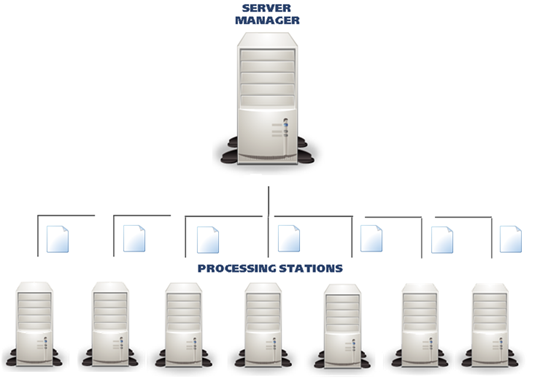Multiple Processing Stations vs. one Processing Station with multiple CPU cores
FineReader Server comprises several components, of which the most important are the Server Manager and the Processing Stations.
The Server Manager is the central component that coordinates the operation of all the other components, controls the processing parameters, creates and manages job queues, distributes jobs among the Processing Stations, and moves output documents to their intended destinations.
A Processing Station is a component responsible for OCR and document conversion. Processing Stations receive jobs from the Server Manager.
The Server Manager can control dozens of Processing Stations. It evenly distributes the workload among the CPU cores available or designated on the Processing Stations to ensure that system runs at its full capacity. This architecture makes FineReader Server highly scalable, enabling it to process very large amounts of documents.
FineReader Server fully supports multi-core and multi-CPU technologies and hyper-threading. The number of CPU cores and Processing Stations that can be used simultaneously is only limited by the parameters of your license.
There are no technical limitation as to the number of Processing Stations that can be connected to one Server Manager. FineReader Server has been successfully tested with over 100 Processing Stations connected to one Server Manager. The speed of processing is almost in direct proportion to the total number of CPU cores available on all of the Processing Station. So, for example, 10 Processing Stations having one CPU core each will process 10 times as many files than one similar Processing Station with the some period of time.

FineReader Server uses the same algorithm to distribute jobs among CPU cores, whether they are used to power one Processing Station or several different Processing Stations. From this stand point, one multi-core Processing Station is no different from multiple Processing Stations with one CPU core each. However, when faced with a choice between one multi-core CPU and several two- or four-core CPUs, please be aware of the following:
- Typically, one multi-core CPU will be slower than the corresponding number of one-core CPUs. For example, an eight-core CPU will perform slightly worse than eight one-core CPUs.
- Using more than 32 logical CPU cores is not advised because several running processes will compete for access to the hard disk and the CPU cache.
- A Processing Station cannot use more than 32 CPU cores.
- In the event of a hardware failure, a Processing Station will become inoperable and all of its CPU cores will be unavailable to FineReader Server until the normal operation of the Processing Station is restored. On the other hand, chances are much lower that all of your multiple Processing Stations will fail at once.
To ensure a stable system performance, we recommend doing the following:
- Using physical servers for your Processing Stations instead of virtual ones, or
- Configuring your virtual machines in such a way that does not allow system resources to be shared by different virtual machines.
3/26/2024 1:49:49 PM